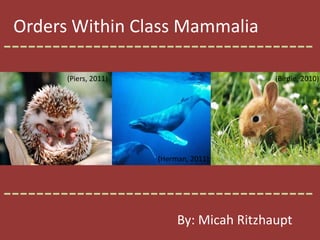
Orders Within Class Mammalia Classification
- 1. Orders Within Class Mammalia -------------------------------------- (Piers, 2011) (Birdie, 2010) (Herman, 2011) -------------------------------------- By: Micah Ritzhaupt
- 3. Have long, narrow snouts and sharp claws that help the animal dig
- 4. Excellent sense of smell and touch
- 5. Poor sense of sight and hearing
- 6. Includes: Shrews, hedgehogs, moles, gymnures, and tenrecs(Angelfire) -------------------------------------- (Levine, J. & Miller, K. ) (myunitybaptist, N.D.) (The bristolral company, N.D.) (quesper, N.D.) (Belardo 2003) (HamourHallow, N.D.)
- 8. Mostly large grazing animals
- 9. Many have horns or antlers
- 10. Includes: Cattle, sheep, goats, pigs, ibex, giraffes, hippopotami, camels, antelope, deer, gazelle(Levine, J. & Miller, K. ) (Angelfire) --------------------------------------- (Animalsgallery, 2010) (Barry, 2000) (Carey, 2007) (Ivana, 2009) (Michigandeercrash, N.D.)
- 12. They’re used for gnawing wood and other plant material
- 14. Very diverse
- 15. Includes: mice, rats, voles, squirrels, gophers, porcupines, chipmunks, gerbils, prairie dogs, and chinchillas(Angelfire) -------------------------------------- (Colin’s Journal, 2004) (Hicker, 2011) (Littlehistories, 2004) (Nps, 2011) (Trendliest, 2011) (Truewildlife, 2011)
- 17. Size differs from 6 ft – 100 ft in length
- 18. Most live and breed in the ocean
- 19. Includes: humpback whales. Narwhals, sperm whales, beluga whales, river dolphin-------------------------------------- (Scarptv, 2010) (Gray, 2009) (Oceanwideimage, 2011) (Robotsystematic 2011) (Portwallpaper, 2011)
- 21. Two pairs of incisors in upper jaw
- 22. Hind legs for leaping
- 23. Includes: Snowshoe hare, and rabbits-------------------------------------- (Wikipedia, N.D.) (Popularpets, 2006) (Livingblossoms, 2008) (Doug, 2008)
- 25. Some eat plants as well
- 26. All have furry or hairy coats
- 28. Includes: dogs, foxes, bears, raccoons, walruses, hyenas, tigers, lions, leopards, cheetahs (Angelfire) -------------------------------------- (National geographic, 2011) (National geographic, 2011) (National geographic, 2011) (National geographic, 2011) (National geographic, 2011)
- 30. Most are very intelligent
- 31. Social structure and behavior
- 32. Includes: Lemurs, tarsiers,baboon, gibbons, macaques, humans(Levine, J. & Miller, K. ) (Angelfire) -------------------------------------- (National geographic, 2011) (National geographic, 2011) (Worldstar, 2011) (National geographic, 2011) (National geographic, 2011)
- 34. Commonly referred to as edentates
- 35. One of the most ancient groups of mammals
- 36. Many species of Xenarthrans are unknown
- 37. Includes Sloths, anteaters, and armadillos.(Hsu, k. & Kang, M. ) (Anteater, sloth, and armadillo.) -------------------------------------- (Xenarthrans, 2011) (Xenarthrans, 2011) (Xenarthrans, 2011)
- 39. Herbivores
- 40. All are either endangered or extinct
- 41. Includes:Horses, Tapirs, Rhinoceroses, and zebras(Levine, J. & Miller, K. ) (Angelfire) --------------------------------------- (Animalsgallery, 2010) (Barry, 2000) (National geographic, 2011) (August, 2004) (National geographic, 2011) (Carey, 2007) (Ivana, 2009) (Michigandeercrash, N.D.) (National geographic, 2011) (National geographic, 2011)
- 43. This order of mammals went through extensive adaptive radiation that produced many species
- 44. Includes: Mastodons, mammoths, Asian elephant, and the African elephant -------------------------------------- (Seveik, N.D.) (Mraz, 2005) (Colin’s Journal, 2004) (University of London, 2006) (Hicker, 2011) (Littlehistories, 2004) (Nps, 2011) (Seveik, N.D.) (Ench gallery,2011) (Trendliest, 2011) (Truewildlife, 2011)
- 48. Includes: Manatees, and dugongs-------------------------------------- (Scarptv, 2010) (Gray, 2009) (Oceanwideimage, 2011) (Travelocity, 2011) (Divephotoguide, 2010) (Robotsystematic 2011) (Portwallpaper, 2011) (Prlog, 2010) (Divephotoguide, 2010)
- 50. Bats equal 1/5 of all mammalian species
- 51. Many live in trees
- 52. They eat mostly insects and fruit nectar, while 3 species feed on blood of other vertebrates
- 53. Includes: bats-------------------------------------- (Wikipedia, N.D.) (Tersigni, 2006) (Durham, 2008) (Popularpets, 2006) (Livingblossoms, 2008) (Netcore, 2010) (Robson, 2011) (Doug, 2008)
- 54. Works Cited Anteater, sloth, and armadillo. Retrieved April 25, 2011 from http://www.xenarthrans.org/ Hsu, k. & Kang, M. (2000). Introduction to xenarthra. Retrieved April 25, 2011 from http://www.ucmp.berkeley.edu/mammal/xenarthra.html Levine, J. & Miller, K. Biology. Boston, Massachusetts: Prentice Hall Angelfire. Retrieved April 19, 2011 from http://www.angelfire.com/mo2/animals1/mammal/insectivora.html